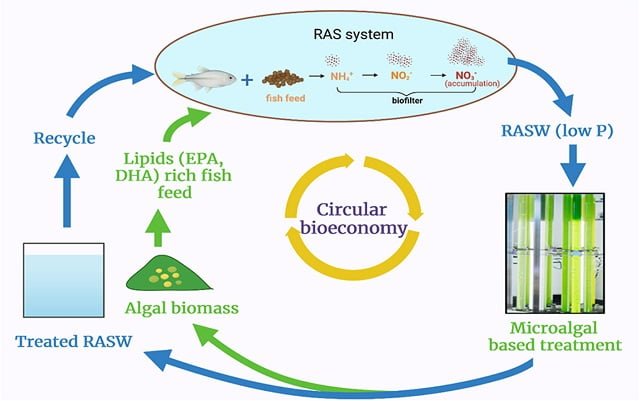
Aquaculture Recirculating Systems (RAS) offer a solution for water reuse and improving the sustainability of aquaculture practices; however, they create a new problem: the accumulation of nitrates in the culture water.
A team of scientists from LUT University (Finland), Luleå University of Technology (Sweden), and Seoul National University of Science and Technology (South Korea) investigated the feasibility of producing biomass from marine microalgae and removing nutrients from the water of aquaculture recirculating systems (RASW) with low phosphate concentration.
The problem: nitrate accumulation in RAS
- 1 The problem: nitrate accumulation in RAS
- 2 Conventional solutions: costly and energy-intensive
- 3 The microalgae solution: beneficial for all
- 4 Optimizing microalgae growth for RAS applications
- 5 The study: Exploring microalgae for phosphate-limited RAS water
- 6 Key findings
- 7 Benefits of this research
- 8 Conclusion
- 9 Entradas relacionadas:
RAS systems are excellent for water conservation, but they create a concentrated environment. Ammonia from fish waste is converted to nitrate by beneficial bacteria. Unfortunately, high levels of nitrate can be toxic to fish. Additionally, releasing this nutrient-rich water into the environment can lead to harmful algae blooms.
Conventional solutions: costly and energy-intensive
Current methods for addressing elevated nitrate levels are often expensive and require a lot of energy. These include:
- Regular water replacement: This wastes water and disrupts the RAS ecosystem.
- External carbon source denitrification: This process requires additional energy input.
- Unconventional methods: Options like ion exchange and membrane filtration are costly to set up and maintain.
The microalgae solution: beneficial for all
This study explores the use of marine microalgae to treat RAS water. Here’s why it’s a promising approach:
- Nutrient removal: Microalgae absorb nitrates and phosphates from the water, cleaning it for reuse.
- Biomass production: Microalgae grow, creating valuable biomass that can be used for:
- Sustainable fish feed: Microalgae biomass is rich in proteins, omega-3 fatty acids, and antioxidants, promoting fish health and reducing mortality.
- Reduced carbon footprint: Microalgae consume CO2 as they grow, helping mitigate climate change.
Optimizing microalgae growth for RAS applications
Several factors influence how effectively microalgae can treat RAS wastewater:
- Microalgae species: Different species have different capacities for nitrate and phosphate absorption.
- Nutrient ratio (N:P): The nitrogen and phosphorus ratio in the water affects microalgae growth. RAS wastewater often has a high N:P ratio due to low phosphate levels.
- Other factors: Light intensity, pH, and temperature also influence microalgae growth.
The study: Exploring microalgae for phosphate-limited RAS water
This research investigated the use of four species of marine microalgae (Nannochloropsis oculata, Pavlova gyrans, Tetraselmis suecica, Phaeodactylum tricornutum) for treating RAS wastewater with low phosphate concentration. These species were chosen for their ability to:
- Accumulate omega-3 fatty acids (valuable for fish feed)
- Thrive under such conditions
The study focused on:
Stay Always Informed
Join our communities to instantly receive the most important news, reports, and analysis from the aquaculture industry.
- Microalgae growth rate in wastewater.
- Nutrient removal efficiency.
- Feasibility of using untreated raw wastewater to achieve profitability.
Key findings
- Microalgae growth: Despite low phosphate levels, all species can grow in RAS wastewater.
- Top cleaner: Tetraselmis suecica emerged as the most efficient nitrate remover, achieving over 80% removal in both regular and vitamin-supplemented wastewater.
- Vitamins make a difference: Adding vitamins significantly boosted Tetraselmis suecica growth.
- Scaling up: Tetraselmis suecica was chosen for further studies in larger bioreactors with additional nitrate supplements. This resulted in a 2.2-fold increase in microalgae growth.
- Fish-suitable feed: Microalgae cultivated in RAS wastewater exhibited a healthy fatty acid profile, making them suitable for fish feed.
Benefits of this research
This study paves the way for practical applications of microalgae in treating RAS water. Here’s what makes it stand out:
- Focus on untreated RAS water: Unlike previous studies, this research used untreated RAS water, reducing treatment costs.
- Focus on high N:P ratio: It explores the use of microalgae in phosphate-limited RAS water, an area needing further research.
- Scaling potential: The study identifies the most effective and cost-efficient microalgae species for further research in larger RAS systems.
Conclusion
This research highlights the potential of microalgae for treating phosphate-limited RAS wastewater while producing valuable fish feed. Future studies will explore:
- Scaling up microalgae production for large-scale RAS applications.
- Identifying the most efficient and cost-effective microalgae species.
- Investigating the overall impact of microalgae treatment on the RAS ecosystem.
The study was funded by BlueBio ERANET Cofund – 2018 Joint Call – DIGIRAS (Maa-ja Metsätalousministeriö – 4400T-0806).
Contact
Parul Jakhwal
Department of Separation Science, LUT School of Engineering Science, LUT University
Sammonkatu 12, FI-50130, Mikkeli, Finland
Email: Parul.jakhwal@lut.fi
Reference (open access)
Jakhwal, P., Daneshvar, E., Skalska, K., Matsakas, L., Patel, A., Park, Y., & Bhatnagar, A. (2024). Nutrient removal and biomass production of marine microalgae cultured in recirculating aquaculture systems (RAS) water with low phosphate concentration. Journal of Environmental Management, 358, 120859. https://doi.org/10.1016/j.jenvman.2024.120859
Editor at the digital magazine AquaHoy. He holds a degree in Aquaculture Biology from the National University of Santa (UNS) and a Master’s degree in Science and Innovation Management from the Polytechnic University of Valencia, with postgraduate diplomas in Business Innovation and Innovation Management. He possesses extensive experience in the aquaculture and fisheries sector, having led the Fisheries Innovation Unit of the National Program for Innovation in Fisheries and Aquaculture (PNIPA). He has served as a senior consultant in technology watch, an innovation project formulator and advisor, and a lecturer at UNS. He is a member of the Peruvian College of Biologists and was recognized by the World Aquaculture Society (WAS) in 2016 for his contribution to aquaculture.




